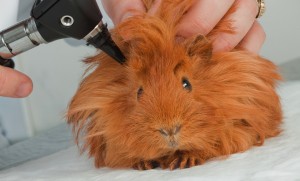WHEN DOES A GUINEA PIG NEED TO SEE A VET?

Its really important to find a vet who is interested in these little animals. Guinea pig illnesses are difficult to diagnose and tests may be necessary. Another difficulty is that guinea pigs respond badly to some antibiotics. Your local guinea pig rescue may know a good vet.
Like all prey animals, guinea pigs hide the fact that they are ill or in pain. These are the symptoms of a guinea pig that is not well:
- The guinea pig stops eating or eats very little. There are therefore fewer droppings in its cage. This is a veterinary emergency. Guinea pigs cannot vomit so their gut transit can slow down or stop altogether. This can be due to lack of fibre in the diet, hair balls, stomach troubles, salmonella, teeth problems, bladder stones or some other diseases (Capello 2006). Occasionally a guinea pig will stop eating out of stress or because it refuses to eat a new food (Lichtenberger & Lennox, 2009) .
- The guinea pig becomes lethargic and moves very little. It may look hunched with sunken eyes (Flecknell 2002)
- The guinea pig seems to be straining to defecate or urinate or screaming when urinating or defecating (Hoeffer 2006, McBride 2011). This may mean it has developed cystitis or bladder stones.
- Diarrhoea or soft faeces.
- Hair loss of any kind or visible skin sores. These require immediate veterinary attention. They may be due to various parasites and can result in fits and even death (Fremont & Bowman 2003). You will have to clean bedding and housing too – take your vet’s advice on what to use.
- Any visible fleas or mites. These may be the result of the guinea pig being in poor health due to other disorders.
- Sneezing, runny nose, runny eyes (Flecknell, 20020). Stressed or malnourished guinea pigs can develop a lung infection (Diethelm-Mader 2009)
- Lumps usually round the neck area. These are swollen and infected lymph glands, often developing in guinea pigs bought in pet shops (Diethelm-Mader 2009).
- Slobbery mouth, wet facial hair and weight loss often due to dental disease and/or a diet without enough fibre.
- Pain. This is difficult to recognise. Guinea pigs go immobile, eat and drink less (Institute for Laboratory Animal Research 2013). Guinea pigs may be dropped by humans or fall off ramps, hurt themselves on their cage or hutch, bite themselves or be bitten by other guinea pigs.
- Swollen or weeping eyes. This can occur if a hay seed gets stuck in the eye.
- Drinking too much and urinating too much. Urine stains at the back end.
- Swollen or sore feet. Called bumblefoot this occurs if guinea pigs are kept on wire floors.
- Head tilted to one side – a lung or ear infection.
Inspect your guinea pig every day, making sure that its feet are not swollen, its eyes are clear, and its skin and fur is fine. Any kind of skin or fur disorder must be taken seriously. Weight loss is also very serious so it is worth regularly weighing your guinea pig. You can get a guinea pig record book, to keep an eye on weight and other health issues, here.
REFERENCES
Diethelm-Mader, G., (2009), ‘Common small mammal emergencies,’ Proceeding of the Latin American Veterinary Conference 2009, 278-283.
Flecknell, P., (2002), ‘Guinea Pigs,’ eds Meredith, A. & Redrobe, S., BSAVA Manual of Exotic Pets, BSAVA, Fourth Edition, Quedgley, Gloucester, UK.
Fremond, J. J. & Bowman. D. D.(2003), ‘Parasites of Guinea Pigs,’ in ed. Bowman D.D., Companion and Exotic Animal Parasitology. Available at www.ivis.org/advances/Parasit_Bowman/fremont/chapter.asp?LA=1 Acccessed 31 December 2013.
Capello, V., (2006), ‘Clinical approach to the anorectic guinea pig,’ Proceedings of the North American Veterinary Conference, vol 20, 1697-1699.
Hoeffer, H. H., (2006), ‘Urolithiasis in rabbits and guinea pigs, Proceedings of the North American Veterinary Conference, vol 20, 1735-1736.
Institute for Laboratory Animal Research, ‘Laboratory Rodents,’ Recognising Pain in Animals, Available at http://nas-sites.org/animal-pain/how-to-recognize-pain-in-animals/laboratory-rodents/ Accessed 31 December 2013.
Lichtenberger, M. & Lennox, A. M., (2009), ‘Exotic Companion Mammal Emergency Medicine and Critical Care,’ Association of Exotic Mammal Veterinarians 2009 Conference Proceedings, 1-15
McBride, A., (2011), Guinea Pigs. Understanding and caring for your pet, Magnet & Steel.